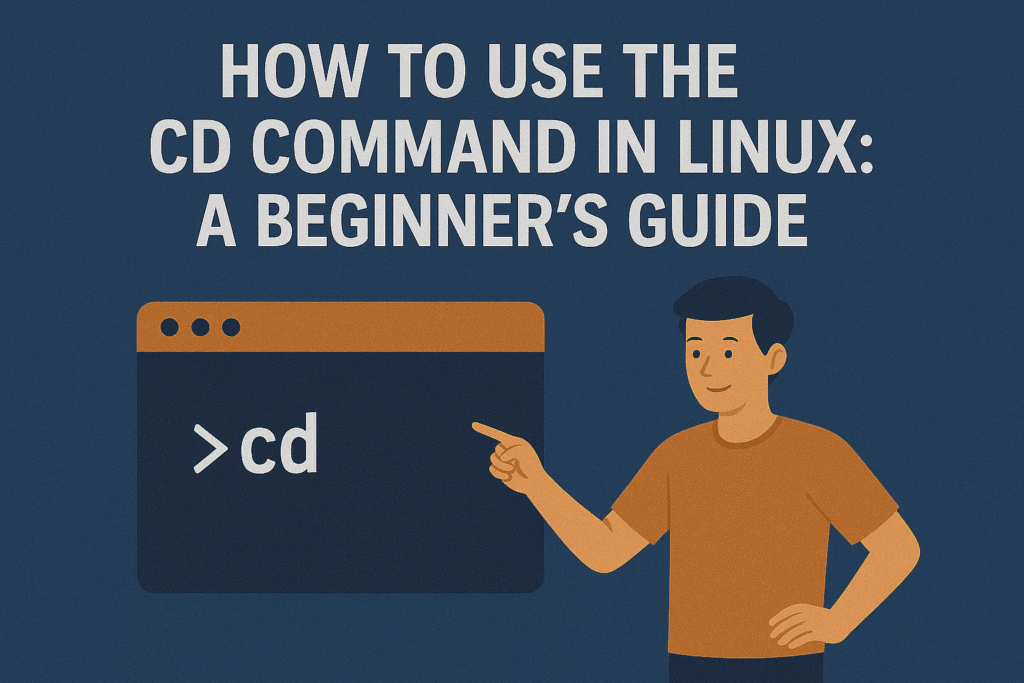Linux
How to Use the Cd Command in Linux: A Beginner’s Guide
Are you eager to navigate the Linux file system with ease? Understanding the ‘cd’ command is your first step to mastering the art of moving through directories in Linux.
Whether you’re new to Linux or just need a refresher, this guide will simplify the ‘cd’ command for you. Imagine the satisfaction of effortlessly accessing files and folders, just by typing a few letters. You’ll discover how the ‘cd’ command can transform your Linux experience, making your workflow smoother and more efficient.
Stick with us as we dive into practical tips and tricks that will empower you to use this command like a pro. Ready to unlock the secrets of efficient file navigation? Let’s get started!

Cd Command Basics
Learning Linux commands can be a bit tricky at first. The cd command is one of the most basic and essential commands. It helps you move around your file system with ease. Understanding its basics will make your Linux experience smoother.
Definition And Purpose
The cd command stands for “change directory.” Its main purpose is to navigate between directories in Linux. It’s like opening folders on your computer. With this command, you can access different parts of your file system.
Syntax Overview
Using the cd command is straightforward. The basic syntax is cd [directory]. Replace [directory] with the path you want to go to. For example, typing cd /home/user moves you to the “user” directory inside “home.”
To go to your home directory, just type cd without any arguments. Use cd .. to move up one directory level. It’s simple once you understand these basics.
Navigating Directories
Linux users often find themselves needing to navigate through directories, and mastering the cd command is essential for efficient file management. Whether you’re a seasoned developer or a beginner exploring Linux for the first time, understanding how to use the cd command can significantly enhance your productivity. Let’s dive into the basics of navigating directories using the cd command.
Changing To Home Directory
Have you ever been lost in a maze of directories and wished you could just start fresh? Simply typing cd without any arguments takes you straight to your home directory. It’s like hitting the reset button. This is especially handy when you’ve wandered deep into your filesystem and need to return to familiar territory quickly. Try it out next time you’re exploring—you’ll appreciate the simplicity.
Switching To Specific Paths
Need to jump to a particular directory? Use cd /path/to/directory to navigate directly to it. This method saves time and avoids the hassle of stepping through each directory manually. Just remember to use the absolute path, which starts from the root directory, to ensure you land exactly where you want. Do you have a favorite directory you visit often? Bookmark its path in your mind or notes for quick access using cd.
Using Relative Paths
Relative paths offer flexibility when you’re working within a project folder. If you need to move up one directory, use cd ... This is particularly useful when navigating within nested directories. Want to move sideways to another directory at the same level? Just type cd ../another-directory. Experiment with relative paths to streamline your workflow—it’s like finding shortcuts in a complex city grid.
As you become more comfortable with the cd command, you’ll find navigating through Linux directories becomes second nature. Practice with different paths and discover how you can streamline your file management. Which method do you find most efficient for your daily tasks?
Advanced Directory Navigation
Linux users often need efficient directory navigation. The cd command is essential for this purpose. Basic usage might be straightforward. However, advanced navigation techniques offer greater control and efficiency. These methods enhance productivity and simplify complex tasks.
Navigating Up The Directory Tree
To move up one level in the directory, use cd ... This command takes you to the parent folder. It’s helpful for quickly accessing higher-level directories. You can repeat cd .. multiple times. This allows for reaching any desired parent directory.
Utilizing Parent Directory Symbol
The double-dot symbol (..) represents the parent directory. Using it with paths gives flexibility. For example, cd ../sibling_folder moves to a sibling folder. This technique saves time by reducing typing. It also minimizes navigation errors.
Moving Between Previous Directories
Switching back to a previous directory is easy. Use cd - to return to the last directory. This command toggles between current and previous locations. It enhances navigation efficiency. Especially useful for frequent directory switches.

Credit: www.geeksforgeeks.org
Common Errors And Solutions
Mistyping directory names often leads to errors with the cd command in Linux. Ensure correct case-sensitive spelling to navigate effectively. Use “cd ~” to return to the home directory, avoiding path errors.
Navigating the Linux terminal can feel like stepping into a maze if you’re not familiar with the cd command. While it’s a powerful tool for changing directories, it can sometimes lead you into a web of errors. Understanding these common issues and how to solve them can save you time and frustration. Let’s dive into some of the usual roadblocks you might encounter and how to overcome them effectively.
###
Handling Non-existent Paths
One of the most frequent errors is trying to change to a directory that doesn’t exist. This usually happens due to a typo or incorrect path. Always double-check the spelling and ensure the path is correct.
You can use the ls command to list files and directories in your current location. This helps confirm the existence of the directory you want to navigate to. If the directory doesn’t exist, you’ll need to create it or find the correct path.
Instead of memorizing complex paths, use the tab key for auto-completion. It’s a lifesaver that reduces errors and speeds up navigation. Have you ever wondered how much time you could save with just a simple habit change?
###
Resolving Permission Issues
Another common stumbling block is permission issues. You might try to access a directory only to be met with a “Permission denied” message. This can be frustrating, especially if you’re in a hurry.
Check if you have the necessary permissions to access the directory. The ls -l command can show you the permissions of directories and files. If you don’t have access, you might need to request permission from an administrator or use sudo if you have admin rights.
Remember to be cautious when using sudo as it grants elevated privileges. Misuse can lead to unintended changes in your system. How often do you find yourself needing extra permissions, and are you careful when you do?
Breaking down these errors into manageable pieces can make your Linux experience smoother. Understanding these issues also empowers you to tackle other command line challenges with confidence. Whether you’re a beginner or a seasoned user, mastering these solutions is key to efficient Linux navigation.
Practical Examples
Understanding the cd command in Linux is essential for navigating directories. Practical examples help users grasp its usage effectively. This section illustrates how to change directories step-by-step and explore real-world applications. These examples make learning the cd command accessible and straightforward.
Step-by-step Directory Changes
Begin by opening your terminal. Type cd followed by the directory name. For instance, cd Documents moves you to the Documents folder. Use cd .. to go back to the previous directory. Want to return to the home directory? Just type cd without any arguments.
Explore further by trying cd /usr/local. This takes you to the local directory within the usr folder. Remember, paths are case-sensitive. Double-check your spelling to avoid errors.
Real-world Use Cases
Developers often use cd to navigate to project directories. For instance, cd /var/www/html accesses web files on a server. System administrators use cd to manage system files efficiently.
Consider a scenario of organizing files. Use cd Downloads to access downloaded files quickly. From there, create new folders or move files as needed. This practical command enhances productivity by simplifying navigation.
Tips And Tricks
Learning how to navigate directories in Linux can feel overwhelming. The cd command is essential for this task. It helps you move through directories seamlessly. Improving efficiency with this command can save time. Below are some tips and tricks to enhance your Linux navigation skills.
Speeding Up Navigation
Using shortcuts can make navigation faster. Type cd - to return to the last directory. This shortcut saves typing time. Use cd ~ to go directly to your home directory. These commands reduce keystrokes. They make moving between directories swift and simple.
Combining Commands For Efficiency
Combine commands to boost efficiency. Use cd && ls to change directories and list files simultaneously. This reduces time spent on separate commands. Use semicolons to link multiple commands. cd folder; mkdir newdir changes directories and creates a new one. This technique streamlines workflow.

Credit: monovm.com
Frequently Asked Questions
How Is Cd Command Used In Linux?
The “cd” command in Linux changes the current directory. Use “cd /path/to/directory” to navigate. Typing “cd” alone returns you to the home directory. Combine “cd” with “. . ” to move up one directory level.
How To Use The Cd Command In Terminal?
Use the ‘cd’ command to change directories in the terminal. Type ‘cd’ followed by the path. Example: ‘cd /path/to/directory’. Use ‘cd. . ‘ to move up one directory. To return to the home directory, simply type ‘cd’.
How To Run Linux From Cd?
Boot your computer with the Linux CD inserted. Select the option to run Linux live from the CD. Follow on-screen instructions to explore Linux without installation.
How To Cd Into Previous Directory?
Use the command cd - in your terminal to switch to the previous directory quickly. This command helps navigate back to the last location you were in, enhancing efficiency while working in the command line. Make sure you use the hyphen right after cd without any spaces.
Conclusion
Mastering the cd command simplifies navigation in Linux systems. It’s essential for managing directories. Practice using cd to move between folders quickly. Experiment with different paths to understand its functionality. Remember, practice makes perfect. Familiarity with this command boosts your efficiency.
It saves time and reduces errors. Soon, you’ll navigate Linux like a pro. Keep practicing. Explore different scenarios. Build confidence. The cd command is a fundamental Linux skill. Whether for personal or professional use, mastering it is beneficial. Enjoy your Linux journey.
Happy navigating!
-

 DevOps6 years ago
DevOps6 years agoSaltstack Tutorial for beginners [2025]
-

 DevOps6 years ago
DevOps6 years agoHow to build a Docker cron job Container easily [2025]
-

 Linux7 years ago
Linux7 years agomail Command in Linux/Unix with 10+ Examples [2025]
-

 DevOps6 years ago
DevOps6 years agoDocker ADD vs COPY vs VOLUME – [2025]
-

 DevOps6 years ago
DevOps6 years agoHow to setup Pritunl VPN on AWS to Access Servers
-

 Linux7 years ago
Linux7 years agoGrep Command In Unix/Linux with 25+ Examples [2025]
-

 Linux7 years ago
Linux7 years agoFind command in Unix/Linux with 30+ Examples [2025]
-
Linux5 years ago
How To setup Django with Postgres, Nginx, and Gunicorn on Ubuntu 20.04

